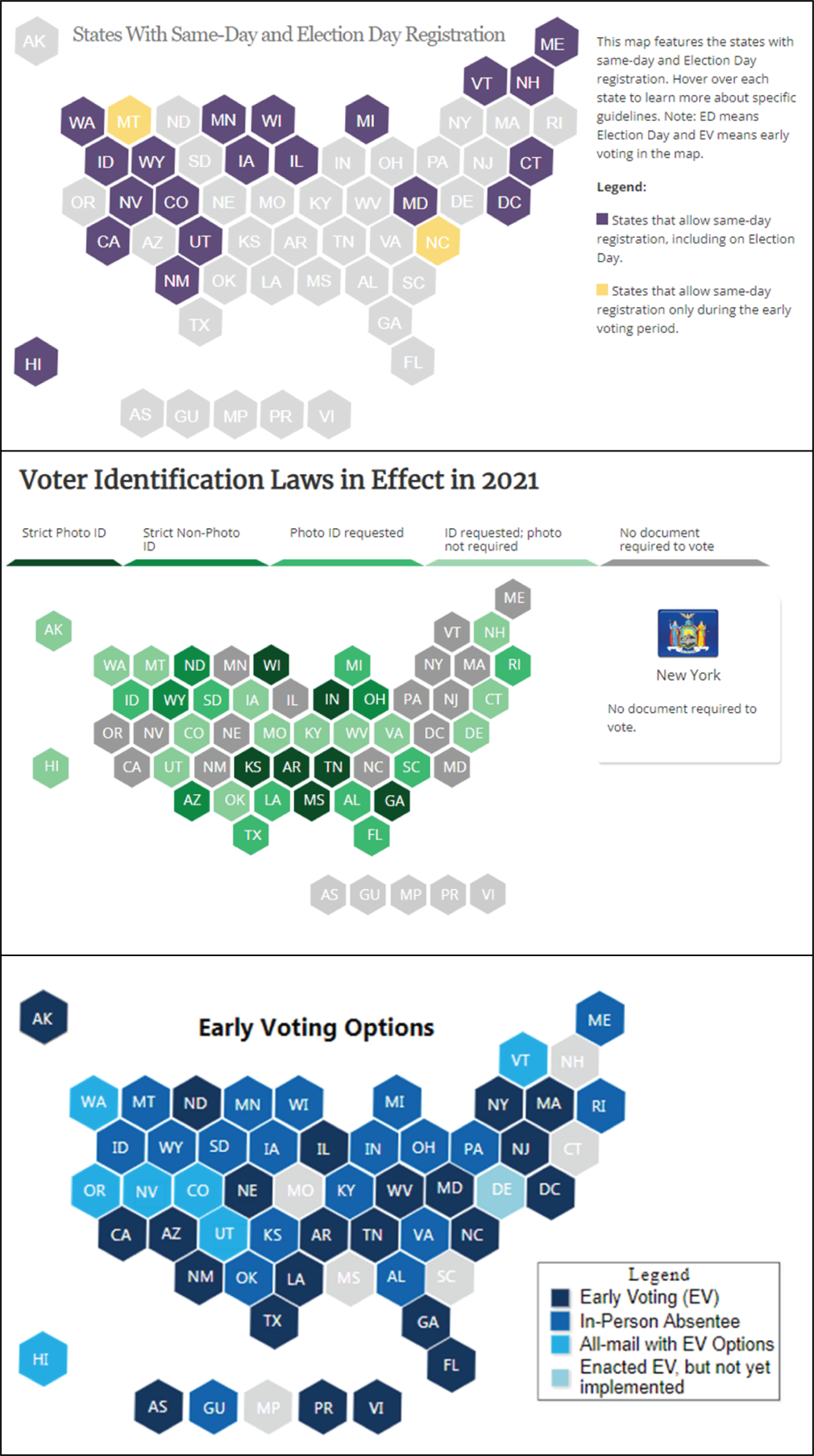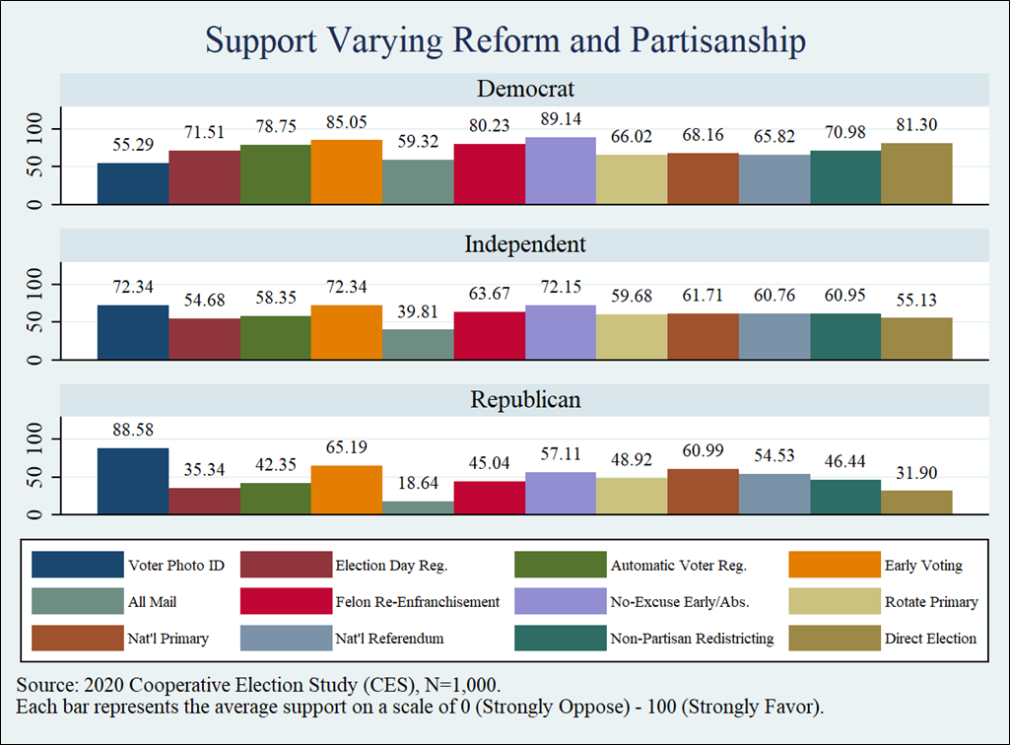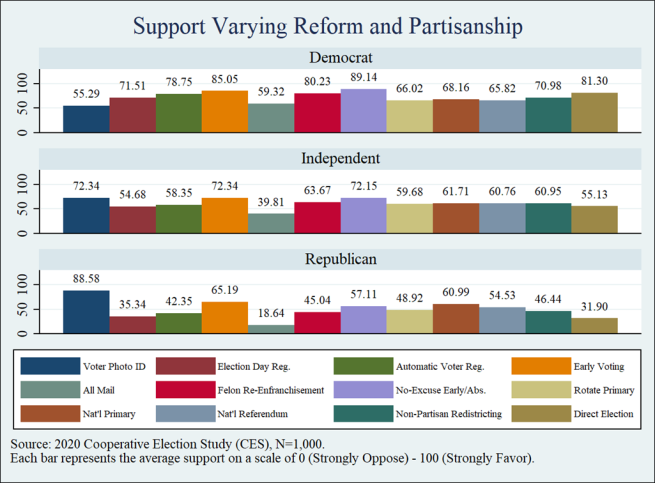Understanding Policy Mood for US Election Reform
The MIT Election Data and Science Lab helps highlight new research and interesting ideas in election science, and is a proud co-sponsor of the Election Sciences, Reform, & Administration Conference (ESRA).
Our post today was written by Joseph Coll, Caroline Tolbert, and Michael Ritter, based on their paper presented at the 2021 ESRA Conference. The information and opinions expressed in this column represent their own research, and do not necessarily represent the opinions of the MIT Election Lab or MIT.
About the Research
The last decade has seen a decrease in American’s satisfaction with government and the democratic process, leading two-thirds of Americans to say ‘significant changes’ are needed in the design and structure of US democracy. Thus, it is not surprising that a recent Pew Research Center survey found that 6 in 10 Americans favor automatically registering all eligible citizens to vote and nearly 8 in 10 favor a two-week long early, in person voting period. Beyond access to voting, there is growing support for structural reforms of the electoral system. The same 2021 Pew survey found nearly half of the American adults favor independent legislative redistricting commissions and a majority support electing the presidential candidate who receives the most popular votes nationally rather than winning in the Electoral College.
Despite these patterns in election reform preferences, there have been only limited previous attempts to measure election reform policy mood in a systematic way. While laws governing access to voting vary significantly across the fifty states (see Figure 1), do individual attitudes across many different type of election reform changes align to create a mood for more or less election reform? Instead of focusing on how election laws affect political behavior, as is often done in previous research, this study analyzes individual preferences for overall election system change among the general public and across different partisans.

Electoral Reforms Across the U.S. States. Top: Same/Election Day Registration; Middle: Early, Absentee, and Mail Voting; Bottom: Voter ID Requirements. All figures taken from the National Conference of State Legislature’s website.

Electoral Reforms Across the U.S. States. Top: Same/Election Day Registration; Middle: Early, Absentee, and Mail Voting; Bottom: Voter ID Requirements. All figures taken from the National Conference of State Legislature’s website.
Today, politicians and pundits also frequently tie election system reforms to political party success, increasing the partisan salience of these laws and causing stark differences in public opinion. In line with this trend, survey experiments by Daniel Biggers have shown that partisans increase/decrease their support for electoral reforms based on how they think that reform will affect their party’s success at the ballot box. Our survey data finds just under two-in-10 Republicans favor exclusively mail voting compared to six-in-then among individuals who identity with the Democratic party. Conversely, only 61% of Democrats support voter identification (ID) requirements, while Republicans near-unanimously support the requirement.
In light of these trends, this study investigates public support for voting access reforms side by side with structural changes of US elections. Twelve questions were asked on a nationally representative survey of 1,000 Americans (2020 Cooperative Election Study) to measure public support for different electoral reforms. Questions asked about the respondent’s support for rotating the order of presidential primaries, holding a national primary on a single day, allowing for a national referendum, directly electing the president using the popular vote, the use of non-partisan legislative redistricting commissions, automatically registering voters when they interact with government agencies (automatic voter registration), allowing voters to register and vote on Election-Day (Election-Day registration), allowing registered voters to cast a ballot in the weeks leading up to an election (early voting), conducting elections by mail (all-mail elections), requiring photo voter identification (voter ID), felon re-enfranchisement post-serving their sentence, and allowing registered voters to cast an absentee ballot without requiring an excuse (no-excuse absentee voting). Preferences for these reforms are measured on a 1-5 scale (strongly disagree to strongly agree with no opinion in the middle), with higher values representing greater support. To aid in interpretation, we transform this scale to range from 0-100, with 0 representing no support and 100 representing strong support. Support for individual election reforms are summarized first and then the overall election ‘reform policy mood’ index.
Looking at support for electoral reforms among the general public, results show majority support for every reform with the exception of conducting elections entirely by mail, favored by just two-in-five US adults (42%). Three-in-four Americans (75%) approve of early and no-excuse absentee/mail voting while most other election law changes are favored by over 3 in 5 Americans. Other election reforms with high approval by the US public include the direct election of the US president (rather than through the Electoral College) (60%), non-partisan redistricting (61%), a national referendum (61%), automatic voter registration (62%), felon re-enfranchisement laws (66%), and voter identification laws (70%). These high levels of support for election reform underscore the dissatisfaction of Americans with the way elections are conducted and accessed, as well as their desire to alter the process. Even the least popular reform, conducting elections entirely through mail, receives just under majority support.
Breaking down these numbers by partisan identification tells a somewhat different story (see Figure 2). Here we use a standard three category party identification question with independents leaning Democrat and independents leaning Republican categorized as independents, while strong and moderate Democrats (Republicans) are combined into a single category of Democrats (Republicans). Among Democrats, every reform receives majority support, with Election-Day registration, automatic voter registration, early voting, felon re-enfranchisement, no-excuse absentee/mail voting, non-partisan redistricting, and direct election of the president supported by 7-in-10 self-identified Democrats. Republicans, on the other hand, show majority support for voter IDs, early voting, no-excuse absentee/mail voting, holding a national primary, and allowing for national referendums, with IDs supported by nearly 9/10 Republicans. Independents fall somewhere between Republicans and Democrats for each reform. For some reforms, such as automatic voter registration and holding a national primary, Independents more closely resemble Republicans. For others, like non-partisan redistricting, Independents look more like Democrats.

Figure 2: Support for Electoral Reforms Varying Partisanship
Americans not only have preferences regarding individual reforms, but these preferences for individual reforms culminate into an underlying ‘mood’ for more or less reform. That is, preferences for individual reforms compound to color the extent to which someone thinks the whole system needs to be reformed, resulting in a mood towards more or less reform in general, much like individuals have a mood for more or less government spending. To examine public mood towards election reform policy, we create an index ranging from 0-100, where 0 reflects preferring no changes to US election laws and 100 denoting strongly favoring all 12 reforms discussed above. Results show that there is high policy mood for large-scale structural change to the US election system, with average overall policy mood at 63 on the 0-100 scale. That is, nearly 2/3 Americans think the overall election system needs large reforming. When breaking this down by partisanship, we see similar patterns as shown in Figure 2. Specifically, Democrats exhibit the highest election reform policy mood (73), Republicans the least (50), and independents falling right about in the middle (61). Yet, even when broken down by partisanship, we still find that a majority a supermajority of Americans is in favor of reforming the way elections are conducted.
Recent years have seen increased scrutiny regarding how elections are conducted in the United States. Previous elections have called into question the extent to which Americans are satisfied with the way elections are run, whether they feel they have adequate access to the registration and voting process, and whether elections need to be reformed. Further, political debate has heightened the perceived partisan consequences of electoral reforms, such that preferences for electoral reforms often are divided along partisan lines. Given these trends, we investigate the extent to which the American public in general, and partisans specifically, support specific electoral reforms and broad election system reform. Despite partisan differences, we find there is generally high support for many specific electoral reforms, particularly early voting, no-excuse absentee/mail voting, and voter identification. Additionally, Americans appear to desire broad changes to US elections, with nearly 2/3 in support of wide-scale election change. These results identify key areas of bipartisan support for election reform, noting areas where legislators and election administrators would have the backing of the American public should they decide to reform elections.
Given these findings among the general public, it is worth also considering how these patterns compare to local election officials. A recent paper presented at the 2021 Meeting of Election Sciences, Reform and Administration provides some evidence that partisan citizens and co-partisan election officials have somewhat similar opinions. The study compares perceptions of elections and electoral reforms between the general public and local election officials, highlighting partisan differences. The results find that the views of partisans in the public are often repeated by partisan local election officials (e.g., Republican partisans and officials less accepting of making voting more accessible), but that partisan differences tend to be more muted among election officials. Thus, high election reform policy mood uncovered in the general public may also exist among local election administrators, which may be worth investigating further.

